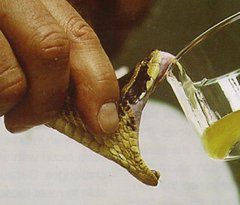Snake Identification
Did you know that 20 of the 25 most venomous snakes in the world are found in Australia?
Australia is the only continent where venomous snakes (70%) outnumber non-venomous ones. Australia's deadliest snakes are the brown snakes (responsible for around 60% of deaths caused by snakebite) and the venomous land snake on Earth (tested on mice) is the Inland Taipan found in arid regions of central Australia.
Snake Identification 101
According to Tropical Topics newsletter produced by Stella Martin at the Queensland Environmental Protection Agency, there are six main snake families in Australia--elapids (venomous snakes, the largest group), colubrids ( mostly 'harmless' snakes) pythons, blindsnakes, file snakes and sea snakes.
Snake Identification: Serpent Classification
A major classification of Australian venomous snakes taken from the University of Sydney Discipline of Anaesthesia community articles include Brown Snake, (Eastern, Gwardir, Dugite), Taipan, Tiger Snake, Death Adder, Copperhead, King Brown Snake (Mulga snake), Redbellied Black Snake, Rough Scaled Snake, and Inland Taipan (Small Scaled snake).
Snake Identification: Snakes and Venoms
Snake identification or description is very crucial because not all snakes are venomous, and because different kinds of anti-venom exist for every specie of snake. For snake identification, doctors may use a Snake Venom Detection Kit (SVDK) to examine the traces of venom left in the bitten area.
It is estimated that between 50,000 and 60,000 people die of snake bite each year around the world. By comparison, in Australia, it is estimated snakebites incidence are between 3 and 18 per 100,000 with an average mortality rate of 4 per 100,000 every year.
Snake Identification: Death and Causes
Some deaths are sudden, however it is uncommon to die within four hours of a snake bite. If untreated, high levels of venom could cause death in a short time. Despite of this, very few deaths result from snake bites because of the availability and wide access to anti-venom in recent years.
 Snake venoms are a complex mixture of polypeptide and other molecules that adversely affect multiple homeostatic systems within their prey in a highly specific and targeted manner. Amongst the most potently toxic venoms in the world are these major Australian venomous snakes, and so snake identification has become a crucial part of survival among the snake-bite victims.
Snake venoms are a complex mixture of polypeptide and other molecules that adversely affect multiple homeostatic systems within their prey in a highly specific and targeted manner. Amongst the most potently toxic venoms in the world are these major Australian venomous snakes, and so snake identification has become a crucial part of survival among the snake-bite victims.
Snake Identification: Impact on Culture
These hypercarnivore reptiles are celebrated for centuries in history and religion as a highly-symbolic animal. Modern studies have been made to understand there biology and behavior. Snakes are shy by nature and will only bite animals or humans if they feel threatened or looking for food. Subsequently, most snakebites occur when people try to catch or kill them.

